8 books by Ley, Graham
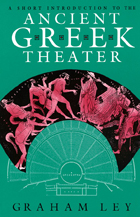
Graham Ley
University of Chicago Press
Contemporary productions on stage and film, and the development of theater studies, have created a new audience for ancient Greek drama. This volume fills the need for a clear, concise statement of what is known about the original conditions of production for tragedy, comedy, and satyr play in the age of Pericles and provides observations on all aspects of performance.
Reexamining the surviving plays of the tragic writers Aeschylus, Sophocles, and Euripides and of the comedian Aristophanes, Graham Ley discusses the actor's technique, the power and range of the chorus, the use of theatrical space, and parody in the plays. A series of diagrams relates the theater to the city and political life of ancient Athens, and photographic illustrations of scenes from Greek vases document the visualization of theatrical performance.
An ideal companion to The Complete Greek Tragedies (University of Chicago Press), Ley's work is a valuable user's guide to the critical assessment of modern translations and adaptations of tragedy and comedy. It is designed for all students of Greek drama with an interest in performance, and for theatrical practitioners who require a concise but informative introduction to one of the great periods of world drama.
Reexamining the surviving plays of the tragic writers Aeschylus, Sophocles, and Euripides and of the comedian Aristophanes, Graham Ley discusses the actor's technique, the power and range of the chorus, the use of theatrical space, and parody in the plays. A series of diagrams relates the theater to the city and political life of ancient Athens, and photographic illustrations of scenes from Greek vases document the visualization of theatrical performance.
An ideal companion to The Complete Greek Tragedies (University of Chicago Press), Ley's work is a valuable user's guide to the critical assessment of modern translations and adaptations of tragedy and comedy. It is designed for all students of Greek drama with an interest in performance, and for theatrical practitioners who require a concise but informative introduction to one of the great periods of world drama.
[more]
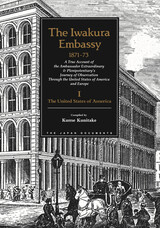
The Iwakura Embassy, 1871-1873, Volume I
The United States of America
Kunitake Kume
MHM Limited, 2002
The newly established Meiji government sent a large delegation on a tour of Western countries to report on how Japan might modernize its political, economic, and social infrastructure. This embassy of some fifty top officials was headed by Iwakura Tomomi and included such luminaries as Ito Hirobumi and Kido Takayoshi. These emissaries journeyed to the United States and eleven European countries, making thorough investigations into each country's politics, military affairs, trade and industry, education, and culture. Their reports, which helped Japan emerge as a modern industrial nation, constitute an indispensable documentary resource. Volume I covers the departure of the Embassy from Yokohama, the Pacific crossing, the arrival in San Francisco, the wintry rail journey across the United States, the unexpectedly long stay in Washington, D.C., and the departure from Boston.
[more]
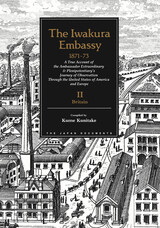
The Iwakura Embassy, 1871-1873, Volume II
Britain
Kunitake Kume
MHM Limited, 2002
The newly established Meiji government sent a large delegation on a tour of Western countries to report on how Japan might modernize its political, economic, and social infrastructure. This embassy of some fifty top officials was headed by Iwakura Tomomi and included such luminaries as Ito Hirobumi and Kido Takayoshi. These emissaries journeyed to the United States and eleven European countries, making thorough investigations into each country's politics, military affairs, trade and industry, education, and culture. Their reports, which helped Japan emerge as a modern industrial nation, constitute an indispensable documentary resource. Volume II covers the period of seventeen weeks from August 16th, 1872, when the ambassadors sighted the Irish coast after a ten-day crossing from Boston, to December 15th, the day before they left Britain for France.
[more]
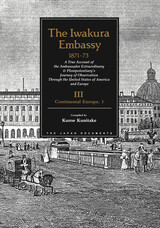
The Iwakura Embassy, 1871-1873, Volume III
Continental Europe, 1
Kunitake Kume
MHM Limited, 2002
The newly established Meiji government sent a large delegation on a tour of Western countries to report on how Japan might modernize its political, economic, and social infrastructure. This embassy of some fifty top officials was headed by Iwakura Tomomi and included such luminaries as Ito Hirobumi and Kido Takayoshi. These emissaries journeyed to the United States and eleven European countries, making thorough investigations into each country's politics, military affairs, trade and industry, education, and culture. Their reports, which helped Japan emerge as a modern industrial nation, constitute an indispensable documentary resource. Volume III covers the first three and a half months of the journey across the Continent, recording the party's impressions in France, Belgium, Holland and Prussia.
[more]
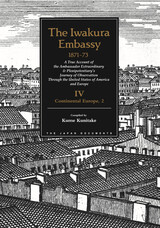
The Iwakura Embassy, 1871-1873, Volume IV
Continental Europe, 2
Kunitake Kume
MHM Limited, 2002
"The newly established Meiji government sent a large delegation on a tour of Western countries to report on how Japan might modernize its political, economic, and social infrastructure. This embassy of some fifty top officials was headed by Iwakura Tomomi and included such luminaries as Ito Hirobumi and Kido Takayoshi. These emissaries journeyed to the United States and eleven European countries, making thorough investigations into each country's politics, military affairs, trade and industry, education, and culture. Their reports, which helped Japan emerge as a modern industrial nation, constitute an indispensable documentary resource. Volume IV covers the journeys made by the various members of the Embassy as they travelled through Russia, Denmark, Sweden, several of the German states, Italy and the Austro-Hungarian empire.
[more]
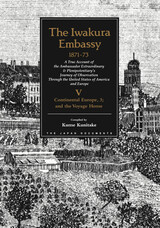
The Iwakura Embassy, 1871-1873, Volume V
Continental Europe, 3; and the Voyage Home
Kunitake Kume
MHM Limited, 2002
The newly established Meiji government sent a large delegation on a tour of Western countries to report on how Japan might modernize its political, economic, and social infrastructure. This embassy of some fifty top officials was headed by Iwakura Tomomi and included such luminaries as Ito Hirobumi and Kido Takayoshi. These emissaries journeyed to the United States and eleven European countries, making thorough investigations into each country's politics, military affairs, trade and industry, education, and culture. Their reports, which helped Japan emerge as a modern industrial nation, constitute an indispensable documentary resource. Volume V covers the ambassadors' visit to the Universal Exposition in Vienna, their travels in Switzerland, the few days they spent in Lyons and Marseilles, and their journey home, during which they travelled through the Mediterranean, the Suez Canal, the Arabian Sea, the Gulf of Bengal and the China Sea, calling at Aden, Galle (in Ceylon), Singapore (where a cholera epidemic prevented their landing), Saigon, Hong Kong and Shanghai.
[more]
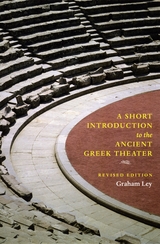
A Short Introduction to the Ancient Greek Theater
Revised Edition
Graham Ley
University of Chicago Press, 2007
Contemporary productions on stage and film, and the development of theater studies, continue to draw new audiences to ancient Greek drama. With observations on all aspects of performance, this volume fills their need for a clear, concise account of what is known about the original conditions of such productions in the age of Pericles.
Reexamining the surviving plays of Aeschylus, Sophocles, Euripides, and Aristophanes, Graham Ley here discusses acting technique, scenery, the power and range of the chorus, the use of theatrical space, and parody in their plays. In addition to photos of scenes from Greek vases that document theatrical performance, this new edition includes notes on ancient mime and puppetry and how to read Greek playtexts as scripts, as well as an updated bibliography. An ideal companion to The Complete Greek Tragedies, also published by the University of Chicago Press, Ley’s work is a concise and informative introduction to one of the great periods of world drama.
"Anyone faced with Athenian tragedy or comedy for the first time, in or out of the classroom, would do well to start with A Short Introduction to Ancient Greek Theater."—Didaskalia
Reexamining the surviving plays of Aeschylus, Sophocles, Euripides, and Aristophanes, Graham Ley here discusses acting technique, scenery, the power and range of the chorus, the use of theatrical space, and parody in their plays. In addition to photos of scenes from Greek vases that document theatrical performance, this new edition includes notes on ancient mime and puppetry and how to read Greek playtexts as scripts, as well as an updated bibliography. An ideal companion to The Complete Greek Tragedies, also published by the University of Chicago Press, Ley’s work is a concise and informative introduction to one of the great periods of world drama.
"Anyone faced with Athenian tragedy or comedy for the first time, in or out of the classroom, would do well to start with A Short Introduction to Ancient Greek Theater."—Didaskalia
[more]
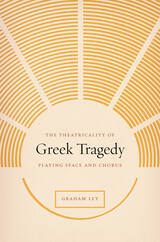
The Theatricality of Greek Tragedy
Playing Space and Chorus
Graham Ley
University of Chicago Press, 2007
Ancient Greek tragedy has been an inspiration to Western culture, but the way it was first performed has long remained in question. In The Theatricality of Greek Tragedy, Graham Ley provides an illuminating discussion of key issues relating to the use of the playing space and the nature of the chorus, offering a distinctive impression of the performance of Greek tragedy in the fifth century BCE.
Drawing on evidence from the surviving texts of tragedies by Aeschylus, Sophocles, and Euripides, Ley explains how scenes with actors were played in the open ground of the orchestra, often considered as exclusively the dancing place of the chorus. In reviewing what is known of the music and dance of Greek antiquity, Ley goes on to show that in the original productions the experience of the chorus—expressed in song and dance and in interaction with the characters—remained a vital characteristic in the performance of tragedy.
Combining detailed analysis with broader reflections about the nature of ancient Greek tragedy as an art form, this volume—supplemented with a series of illustrative drawings and diagrams—will be a necessary addition to the bookshelf of anyone interested in literature, theater, or classical studies.
Drawing on evidence from the surviving texts of tragedies by Aeschylus, Sophocles, and Euripides, Ley explains how scenes with actors were played in the open ground of the orchestra, often considered as exclusively the dancing place of the chorus. In reviewing what is known of the music and dance of Greek antiquity, Ley goes on to show that in the original productions the experience of the chorus—expressed in song and dance and in interaction with the characters—remained a vital characteristic in the performance of tragedy.
Combining detailed analysis with broader reflections about the nature of ancient Greek tragedy as an art form, this volume—supplemented with a series of illustrative drawings and diagrams—will be a necessary addition to the bookshelf of anyone interested in literature, theater, or classical studies.
[more]
READERS
Browse our collection.
PUBLISHERS
See BiblioVault's publisher services.
STUDENT SERVICES
Files for college accessibility offices.
UChicago Accessibility Resources
home | accessibility | search | about | contact us
BiblioVault ® 2001 - 2024
The University of Chicago Press









